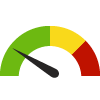Indicator Gauge Icon Legend
Legend Colors
Red is bad, green is good, blue is not statistically different/neutral.
Compared to Distribution
 the value is in the best half of communities.
the value is in the best half of communities.
 the value is in the 2nd worst quarter of communities.
the value is in the 2nd worst quarter of communities.
 the value is in the worst quarter of communities.
the value is in the worst quarter of communities.
Compared to Target
 meets target;
meets target;  does not meet target.
does not meet target.
Compared to a Single Value
 lower than the comparison value;
lower than the comparison value;
 higher than the comparison value;
higher than the comparison value;
 not statistically different from comparison value.
not statistically different from comparison value.
Trend

 non-significant change over time;
non-significant change over time; 
 significant change over time;
significant change over time;  no change over time.
no change over time.
Compared to Prior Value
 higher than the previous measurement period;
higher than the previous measurement period;
 lower than the previous measurement period;
lower than the previous measurement period;
 no statistically different change from previous measurement period.
no statistically different change from previous measurement period.
 Significantly better than the overall value
Significantly better than the overall value
 Significantly worse than the overall value
Significantly worse than the overall value
 No significant difference with the overall value
No significant difference with the overall value
 No data on significance available
No data on significance available
Age-Adjusted Death Rate due to Homicide
This indicator is archived and is no longer being updated. Click to learn more
Why is this important?
Homicides and other violent acts cause substantial harm in communities across the country (Centers for Disease Control and Prevention). Almost 20,000 people die from homicide every year in the United States, and many more people are injured by violence (Healthy People 2030). Strategies to prevent intimate partner violence, child abuse and neglect, and youth violence are critical for reducing homicides (Healthy People 2030).
Considerations for Equitable Approaches: Young people are disproportionately impacted by violence in their communities, including firearm injuries and deaths. Racially segregated and high-poverty neighborhoods are at higher risk of homicides and other violence acts (Centers for Disease Control and Prevention). Communities of color often disproportionately experience violence, with the national homicide rate consistently higher for Black adolescents and young adults compared to their White counterparts (Healthy People 2030). To prevent community violence, it is important to collaborate with different sectors and address the conditions that increase the risk of violence. Street outreach and intervention programs can address immediate risks for violence, while a comprehensive approach addressing societal factors can have the greatest short and long-term impact (Centers for Disease Control and Prevention).
This is a Healthy People 2030 Leading Health Indicator.
The Healthy People 2030 national health target is to reduce homicides to 5.5 deaths per 100,000 population.Measurement period: 2020-2022
Maintained by: Conduent Healthy Communities Institute
Last update: April 2024
Graph Selections
| County | Source | Measurement Period | Deaths per 100,000 population | |
|---|---|---|---|---|
Data Source
- Oklahoma State Department of Health
Maintained By: Conduent Healthy Communities Institute (Methodology)
Filed under: Community / Crime & Crime Prevention, Health / Mortality Data, Health Outcomes



